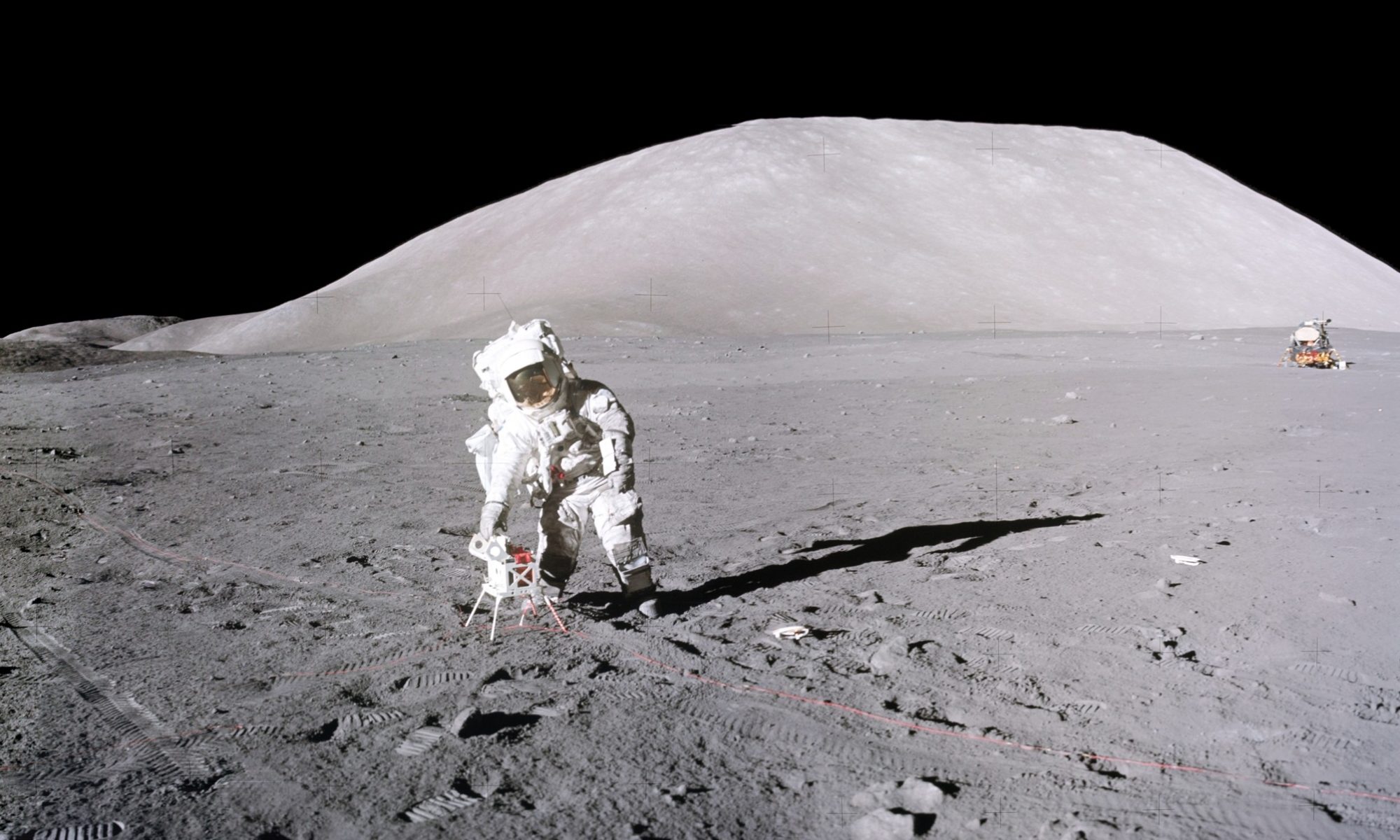 Eric with the star of his life, Dianne, and their faithful Labrador, “Tilly”, in their home at Albury, NSW, Australia. (Photo by Ken and Angele Glover, 2004. Courtesy of the ALSJ).
Eric with the star of his life, Dianne, and their faithful Labrador, “Tilly”, in their home at Albury, NSW, Australia. (Photo by Ken and Angele Glover, 2004. Courtesy of the ALSJ).
Astronomer Dr. Eric Jones worked for more than thirty years at the Los Alamos National Laboratory. He studied a range of topics including atmospheric fireballs, supernova-remnant evolution, and the dispersal of ejecta from the Cretaceous–Paleogene extinction event.
In the mid 1980s, in the hope of an early return to the Moon, Eric starting thinking about the economics of lunar settlement. He visited Houston and began reading the Apollo Air-to-Ground transcripts. He soon realized they were an amazing untapped resource and could serve as the basis for annotated logs similar to New Zealand historian J. C. Beaglehole’s definitive editions of Captain James Cook’s Journals.
On one of my occasional visits to Los Alamos, Eric asked me about the difficulty of working in Lunar EVA gloves and other issues. He spoke about his ideas for an Apollo Lunar Surface Journal (ALSJ), for which, at the time, he believed he had a publication commitment from the University of California. And, in April 1989, we spent three days together going through video and audio for part of Apollo 17 EVA-2. I also wrote a letter of introduction to the other astronauts for him that requested their participation in Eric’s project. With only one exception, the Moon-walking astronauts agreed to participate in recorded discussions about their experiences while viewing mission videos, Hasselblad images, and listening to the recorded audio related to their EVAs.
Between 1989 to 1993, Eric sat down with eleven of the twelve Apollo Moonwalkers (one of these was unable to complete all of his interviews) in Santa Fe, New Mexico, often for days at a time, going through the transcripts, recordings, photos and documents and teasing out information which would be valuable to future explorers. This effort insured that the transcripts attributed audio comments to the correct astronaut. He then transcribed and edited this material, weaving the astronauts’ comments and his own research into the revised transcripts. This was a long-term decades labor of love.
Initially, he imagined the Journal being a multi-volume book, but the University of California decided that they would not participate in its publication. The advent of the public Internet, however, opened up far greater possibilities. In mid-1995 he published the beginnings of the Apollo 17 section of the Journal on a Los Alamos server, and soon the NASA History Office offered to host the ALSJ. On the web, the Journal could include images, audio and video files and hyperlinks to other documents and scanned resources. In addition, a spectrum of volunteers began to add their contributions to the Journal.
Eric’s technical understanding of the missions, his careful attention to detail and his generous ability to include material from many contributors with their own expertise over several decades, has made the ALSJ an unique and invaluable resource for understanding the Apollo missions and also for planning a return to the Moon. A listing of the many volunteers who made contributions and also helped Eric make the numerous web hyperlinks for the large quantity of source material can be found at the bottom of the homepage of the ALSJ (https://www.nasa.gov/history/alsj/).
The Journal has been an indispensable accessory as I have been writing my “Diary of the 12th Man”. Indeed, as the Journal’s edited Apollo 17 EVA transcripts were fully vetted by Eric and his astronaut colleagues, they became the basis for my personal annotation as the Diary took form.
In 2023, Eric was the recipient of the NASA Distinguished Public Service Medal in recognition of his enormous contribution to Apollo history.
Eric died in his adopted hometown of Albury, New South Wales on July 5th, 2025 and is survived by his Australian bride Dianne who has encouraged and supported him all the way through his creation of the Apollo Lunar Surface Journal.
 In his element at an Apollo Reunion in Canberra in 2006, Eric chats with three key players in bringing the Apollo 11 EVA TV to the world (left-to-right): David Cooke, Senior RF Engineer, Parkes Radio Telescope; Ed von Renouard (“Video Von”), who processed the Slow Scan TV from the Moon with the Scan Converter at Honeysuckle Creek during the Apollo 11 EVA; Eric Jones; Mike Dinn, Deputy Director at Honeysuckle Creek 1967-1970. Mike is wearing his badge for admission to the Mission Operations Control Room in Houston during Apollo 17. (Photo courtesy of John Sarkissian, Operations Scientist, Parkes Radio Telescope).
In his element at an Apollo Reunion in Canberra in 2006, Eric chats with three key players in bringing the Apollo 11 EVA TV to the world (left-to-right): David Cooke, Senior RF Engineer, Parkes Radio Telescope; Ed von Renouard (“Video Von”), who processed the Slow Scan TV from the Moon with the Scan Converter at Honeysuckle Creek during the Apollo 11 EVA; Eric Jones; Mike Dinn, Deputy Director at Honeysuckle Creek 1967-1970. Mike is wearing his badge for admission to the Mission Operations Control Room in Houston during Apollo 17. (Photo courtesy of John Sarkissian, Operations Scientist, Parkes Radio Telescope).
© 2025, Harrison H. Schmitt
